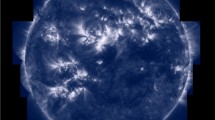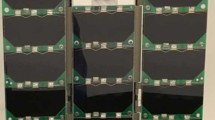Abstract
We review the terms spectral radiance and spectral irradiance, and show how their precise definitions are crucial for interpreting observations made with different instruments covering widely different energy or wavelength ranges. We show how the use of column and volume emission measures in different solar physics and astrophysics communities has led to confusion in relating measured extreme-ultraviolet and soft-X-ray spectra with theoretical spectra generated, in particular, using CHIANTI. We describe a method for obtaining spatially integrated X-ray line and continuum spectra using CHIANTI that requires a column emission measure when only the plasma temperature and volume emission measure, but not the source area, are known from observations.





Similar content being viewed by others
Data Availability
No datasets were generated or analysed during the current study.
Notes
Following most usage in solar physics, c.g.s. units are used throughout this paper.
OSPEX documentation is available on Solar Software (SSW) at /ssw/packages/spex/doc/ospex_explanation.htm.
References
Aschwanden, M.J.: 2004, Physics of the Solar Corona, Springer, Berlin.
Daintith, J.E.: 2009, Oxford Dictionary of Physics, Oxford Paperback Reference (OUP Oxford). https://books.google.com/books?id=N2PEAQAACAAJ.
Del Zanna, G., Mason, H.E.: 2018, Living Rev. Solar Phys. 15, 5. DOI.
Del Zanna, G., Dere, K.P., Young, P.R., Landi, E.: 2021, Astrophys. J. 909, 38. DOI.
Dere, K.P., Del Zanna, G., Young, P.R., Landi, E.: 2023, Astrophys. J. Suppl. 268, 52. DOI.
Dulk, G.A., Dennis, B.R.: 1982, Astrophys. J. 260, 875. DOI.
Koyama, K., Tsunemi, H., Dotani, T., Bautz, M.W., Hayashida, K., Tsuru, T.G., et al.: 2007, Publ. Astron. Soc. Japan 59, 23. DOI.
Krucker, S., Hurford, G.J., Grimm, O., Kögl, S., Gröbelbauer, H.-P., Etesi, L., et al.: 2020, Astron. Astrophys. 642, A15. DOI.
Lin, R.P., Dennis, B.R., Hurford, G.J., Smith, D.M., Zehnder, A., Harvey, P.R., et al.: 2002, Solar Phys. 210, 3. DOI.
Phillips, K.J.H., Feldman, U., Landi, E.: 2012, Ultraviolet and X-ray Spectroscopy of the Solar Atmosphere, Cambridge University Press, Cambridge.
Pottasch, S.R.: 1964, Space Sci. Rev. 3, 816. DOI.
Rapley, C.G., Sylwester, J., Phillips, K.J.H.: 2017, Solar Phys. 292, 50. DOI.
Schwartz, R.A.: 2020, SPEX: Spectral Executive, Astrophysics Source Code Library. Record ascl:2007.017. http://ascl.net/2007.017.
Tolbert, K., Schwartz, R.: 2020, OSPEX: Object Spectral Executive, Astrophysics Source Code Library. Record ascl:2007.018. http://ascl.net/2007.018.
Acknowledgments
We acknowledge the very useful and now widely used CHIANTI atomic code and database, which is a collaborative project involving the University of Cambridge (UK), the NASA Goddard Space Flight Center (USA), the George Mason University (GMU, USA), and the University of Michigan (USA).
We thank Peter Young for help with CHIANTI and Kim Tolbert for help with the RHESSI data analysis software, particularly with OSPEX. We acknowledge the critical reading of an early draft by Albert Shih and Andrew Ingles and the valuable contribution of the referee in greatly improving this paper.
Author information
Authors and Affiliations
Contributions
Both authors wrote the main manuscript text and reviewed the manuscript. BRD prepared the figures.
Corresponding author
Ethics declarations
Competing interests
The authors declare no competing interests.
Additional information
Publisher’s Note
Springer Nature remains neutral with regard to jurisdictional claims in published maps and institutional affiliations.
Appendices
Appendix A: CHIANTI
CHIANTI is a package of Interactive Data Language (IDL) procedures that uses an extensive data base to compute the expected line and continuum emission (free–free, free–bound, and two-photon) from ionized astrophysical plasmas. The emission spectrum can be computed for an isothermal plasma or a plasma with a specified differential emission measure. Temperatures ranging from \(10^{4}\) K to 100 MK can be used with a selection of compositions, densities, and ionization states. The latest version (10.1), used for this paper, is described by Del Zanna et al. (2021) and Dere et al. (2023). An IDL GUI is available (ch_ss.pro) to make setting the input parameters, calculating a spectrum, and generating a plot or an output data file (.genx) relatively straightforward. The User Guide for CHIANTI Version 9 is available on Solar Software (SSW) at /ssw/packages/chianti/doc/cug.pdf. It gives details on using the GUI and on the individual IDL commands when not using the GUI. The main input parameters for an isothermal plasma are log\(_{10}\,T\)(K) and the column emission measure (\(EM_{h}\)) in units of cm−5.
Note that CHIANTI uses \(N_{H}\) rather than \(N_{i}\) in the calculation of column emission measures, where \(N_{H}\) is the density of hydrogen. Since \(N_{H}/N_{i}{\sim 0.83}\) in a plasma with typical solar compositions, the column emission measures are smaller by this factor compared with those calculated using the density of all ions. While this approximate ratio is correct for high-temperature sources observed with RHESSI where both H and He are completely ionized, it is not correct for sources with temperatures below ∼100 000 K where He, at least, is not completely ionized.
The generated spectrum of the spectral radiance (\(I_{E}\)) provided by CHIANTI is in units of photons cm−2 s−1 sr−1 keV−1. Here, the \(cm^{-2}\) refers to the area of the detector and the \(sr^{-1}\) refers to the solid angle into which the photons are emitted (see Figure 1). All of the input and output data are stored in an IDL structure that can be saved in a .genx file and read back into an IDL procedure with the command, regen, for further customized display and analysis.
Appendix B: Object Spectral Executive – OSPEX
OSPEXFootnote 4 is an IDL object-oriented interface for X-ray spectral analysis of solar X-ray and gamma-ray observations (Tolbert and Schwartz, 2020; Schwartz, 2020). Typically, it uses as input the measured count-rate spectra from one of many different spectrometers and fits them to predicted photon spectra based on many different thermal and nonthermal models. It covers the photon energy range from 1.1 keV to 100 MeV and temperatures from \(\sim 5\) to \(>100\) MK.
Generally, limited spatial information is available in this energy range, and consequently the dimensions of the source are not generally known. Hence, OSPEX determines the spectral irradiance in units of photons \({ \mathrm{cm}}^{-2}~{\mathrm{s}}^{-1}~{\mathrm{keV}}^{-1}\) rather than the spectral radiance provided by CHIANTI in units of photons \({\mathrm{cm}}^{-2}~{\mathrm{s}}^{-1}~{\mathrm{keV}}^{-1}~{\mathrm{sr}}^{-1}\), i.e., there is no “per steradians” in the flux units. The \(cm^{-2}\) refers to the area of the detector, as illustrated in Figure 1. Also, for thermal spectra, OSPEX provides the volume emission measure (\(EM_{V}\)) rather than the column emission measure (\(EM_{h}\)) used by CHIANTI.
Rights and permissions
Springer Nature or its licensor (e.g. a society or other partner) holds exclusive rights to this article under a publishing agreement with the author(s) or other rightsholder(s); author self-archiving of the accepted manuscript version of this article is solely governed by the terms of such publishing agreement and applicable law.
About this article
Cite this article
Dennis, B.R., Phillips, K.J.H. Emission Measures Demystified. Sol Phys 299, 48 (2024). https://doi.org/10.1007/s11207-024-02291-1
Received:
Accepted:
Published:
DOI: https://doi.org/10.1007/s11207-024-02291-1




